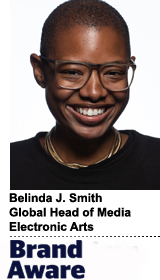
“Brand Aware” explores the data-driven digital ad ecosystem from the marketer’s point of view.
Today’s column is written by Belinda J. Smith, global head of media at Electronic Arts.
Over the past year or so we’ve seen every indication that in-housing will have as much staying power as “The Year of Mobile” – which enjoyed its 10th anniversary this year.
Having previously managed a trading-desk buying team before joining a brand to grow an in-house buying team, I spend much of my time talking about the in-housing trend. I’ve probably been invited to more panels and conferences over the past 18 months than when I ran industry initiatives at the IAB.
Yet it’s very frustrating to me that we’re still talking about in-housing as “advertiser vs. agency.” It is oft positioned as a zero-sum power struggle between brands and trading desks.
While that kind of drama makes for great headlines, it’s also completely false. I don’t know of one in-housing operation that could survive without an agency. Not even Netflix.
Enough with the predictions about the collapse of the agency
Brands taking marketing, media or content in-house does not mean the apocalypse for agencies – quite the contrary.
In just the past 18 months, there’s been growth in agencies’ numbers, services and models. Brands have not eliminated their need for agencies, whether it is the guns-for-hire buying shop that provides scale and buying expertise for a narrow range of channels, the consultancy that is building its own digital and mar tech agency or whatever S4 will become.
In-housing advertisers continue to work with agencies and holding companies; services such as research and insights, communications planning, broadcast and linear TV buying and operations in emerging markets sit almost squarely with agencies.
Our industry will always continue to grow and change, but that doesn’t mean that what’s old is dead. People still watch TV, for God’s sake.
You can’t always be No. 1
In fact, it’s the accelerating rate of change and innovation that keeps agencies in business.
One thing brands quickly realize when bringing capabilities in-house is this: You can’t be the best at everything.
Unless you have committed to hire 300-400 people over the next few years and pay top dollar for leading talent within strategy, research, analytics, insights, content, media, CRM, tech strategy, contracts, legal, privacy, attribution and measurement, you’re going to need help.
And even if you decide to take on everything yourself, not having outside input places you at risk of becoming too insular. Breadth of clients and cross-pollination of ideas is a key benefit agencies can provide. This is almost impossible to replicate in-house.
I’ve always advised brands looking to start their in-house journey to first map out what is crucial for them to own. What is their IP, their competitive advantage or something else that is so precious they can’t outsource it? They should build their in-house discipline around those things and partner on the rest.
Set your agency up for success
Many brands point to savings in media, better content, faster production timelines or better campaign performance as “proof” that agencies are ineffective and in-housing is the only way to succeed going forward.
I’d argue that there are several factors that contribute to many agency failings: agencies being squeezed to provide more services and specialized expertise at a cheaper rate; not taking the time to fully immerse the agency in the brand’s culture and needs; unclear or inconsistent metrics for success; and the hanging threat of “bringing it in-house.” These factors don’t set up either party for success.
Once brands do bring their marketing in-house, they quickly feel their agency’s pain in trying to navigate complex and conflicting needs, stakeholders and definitions of success, along with building a new discipline at a cost that’s palatable to the business.
Those pains are so sharp that most in-housers don’t completely abandon their agency.
Agencies, think about what brands need now
While I don’t think in-housing spells the death of agencies, this is a moment for agencies to reconsider their piece of the value equation and design their offering for what brands need in 2018 and beyond.
At the forefront of those needs is the requirement that agencies provide flexibility and scalability. This is an industry where new opportunities and regulation develop daily, and in these economic times, booms threaten to turn bust overnight. At the same time, consumers are more empowered, educated and fickle than ever before.
The agencies that stand to win big are those that can attract, retain and pivot top talent, build profitable business models from modular and transparent service offerings and have the audacity to scrutinize themselves and their clients. Brands can’t reinvent the wheel alone.
Follow Belinda J. Smith (@BJStech), Electronic Arts (@EA) and AdExchanger (@adexchanger) on Twitter.
This post was syndicated from Ad Exchanger.


More Stories
Here’s How Various News Outlets Will Cover Pope Francis’ Funeral
What Media Rights Deals Mean to the Future of Women’s Sports
Gray Promotes Dana Neves to Senior Managing VP